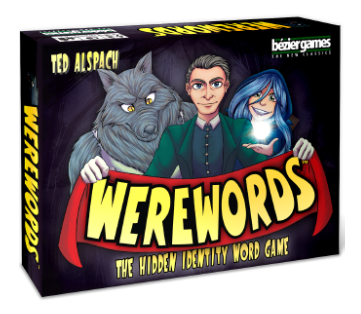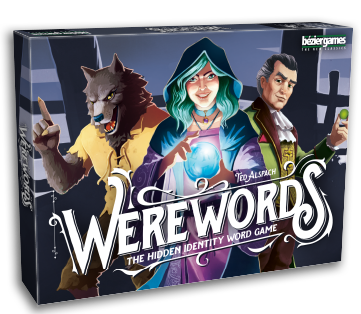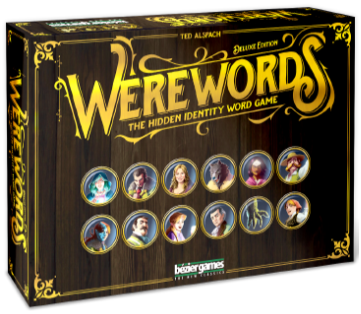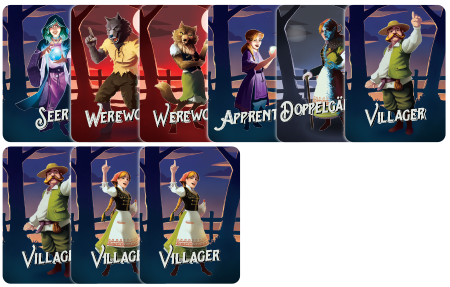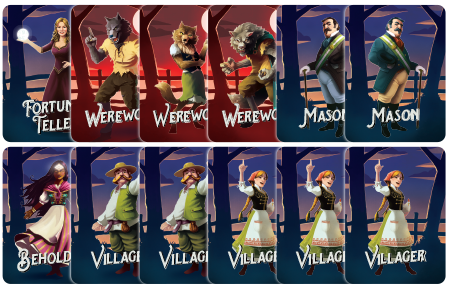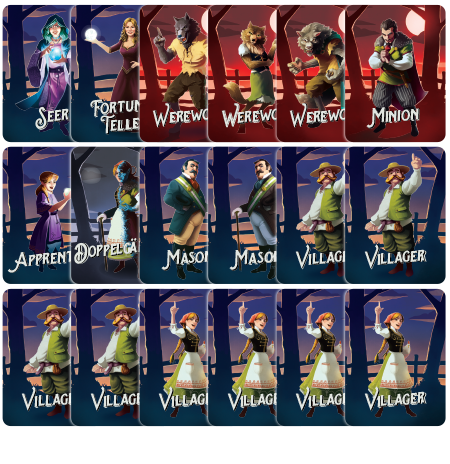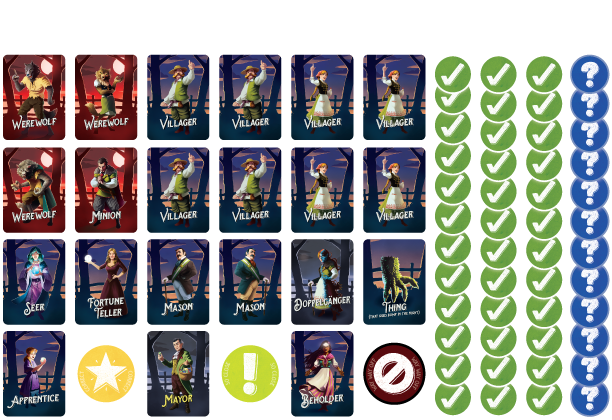
The Amazing Werewords App
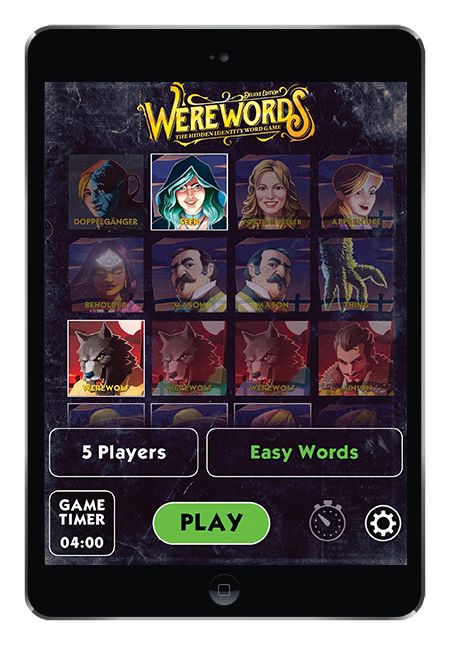
Install the Werewords app on your iOS or Android mobile device (go to beziergames.com to get the app).
Place the device where everyone can see and hear it. If playing with a large number of people, it’s best to use a tablet, so that everyone can see and hear more easily.
The Werewords app walks you through the Night Phase of the game, providing the Magic Word to the Mayor, Seer, and Werewolf. It also includes timers for guessing the Magic Word and for discussion prior to voting.
Open the app and select the roles you want to use on the main screen. A role with a square frame around it is selected (the Mayor is always in play, and does not need to be selected in the app). The number of players is indicated in the leftmost button above the Play button (tap this to quickly increase or decrease player count).
The difficulty level is displayed immediately below the roles on the right. Tap this button to cycle through all four difficulty levels.
The Game Timer button indicates how much time players have to figure out the Magic Word. Tap and hold this to adjust the time.
Tap the Gear button to:
- Select special category word lists (movies, food, sports, etc.)
- Create custom word lists
- Access community word lists
- Determine how many words the Mayor chooses from
- Adjust narration/music volume
- Change the game timer length
- See detailed help for the app
- All other settings in the app
The Werewords app will be updated occasionally with new features, updated word lists, and more, so be sure to use the latest version of the app when you play.
Rules
Game Setup
- Take the Mayor, Seer, and one Werewolf card, and add Villager cards so that the total number of cards is one more than the number of players. For instance, with six players, use the Mayor, the Seer, one Werewolf, and four Villager cards.
If playing with 7–11 players, use two Werewolf cards. If playing with 12 or more players, use three Werewolf cards. - Place the Yes/No (
 /
/ ) tokens in the large compartment in the box and the Maybe (
) tokens in the large compartment in the box and the Maybe ( ) tokens in the small compartment. Slide the large Correct (
) tokens in the small compartment. Slide the large Correct ( ), So Close (
), So Close ( ), and Way Way Off (
), and Way Way Off ( ) tokens in between the plastic insert and the sides of the box.
) tokens in between the plastic insert and the sides of the box. - Shuffle the cards and deal one facedown to each player, leaving one card in the center. Then look at your card secretly. For a six-player game, it would look something like this:
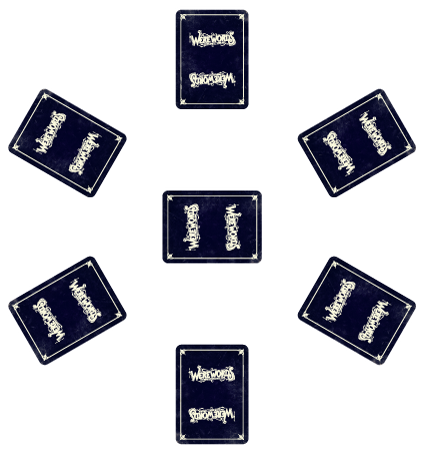
Mayor Setup
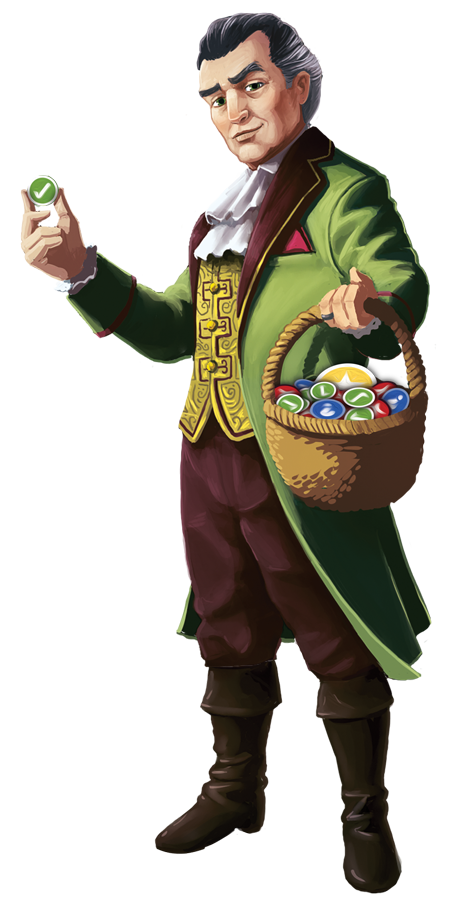
The player with the Mayor card reveals his card, then takes the center card and looks at it secretly—this is the Mayor’s secret role. He places the box with the tokens in front of himself.
Finally, he places the mobile device near enough for him to reach it, but still as close as possible to the other players.
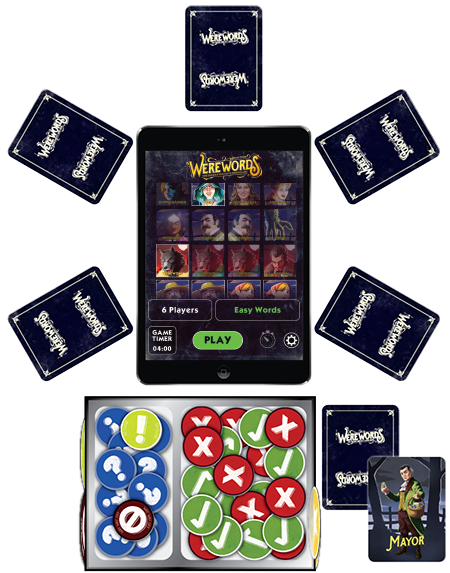
If no player has the Mayor card, the player to the left of the last Mayor takes the center card (which is the Mayor card) and reveals it. If this is the first game, redeal the cards until one player gets the Mayor card.
Gameplay: Night Phase
To start the game, the Mayor presses the Play button on the app. The app tells all players to close their eyes. Then it tells the Mayor to wake up and tap his secret role. The Mayor opens his eyes and taps his secret role (such as a Villager, Werewolf, or Seer) in the app.
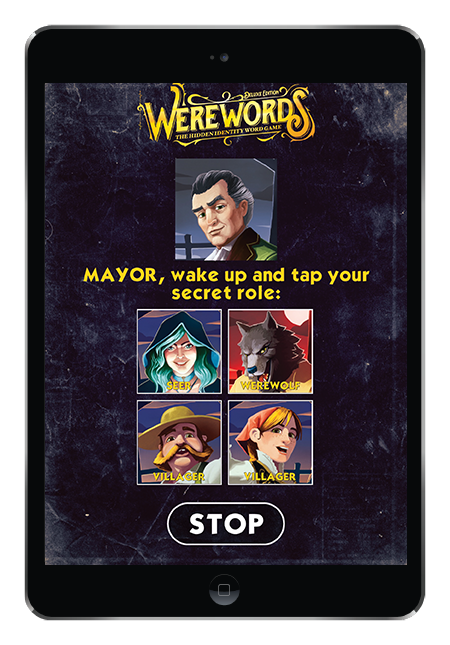
Next, the Mayor chooses a Magic Word from the options shown. The Mayor should choose a Word that he thinks the players will be able to guess.
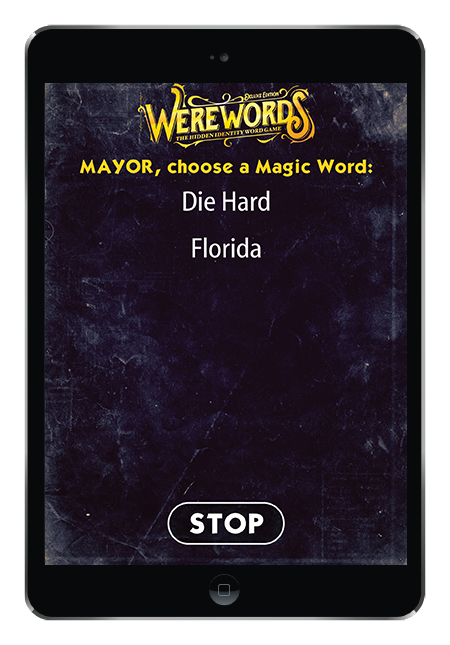
The Magic Word is shown to the Mayor to confirm his selection. Then the app tells the Mayor to close his eyes.

Next, the app tells the Seer to wake up. The Seer views the Magic Word, and then the app tells the Seer to close her eyes.
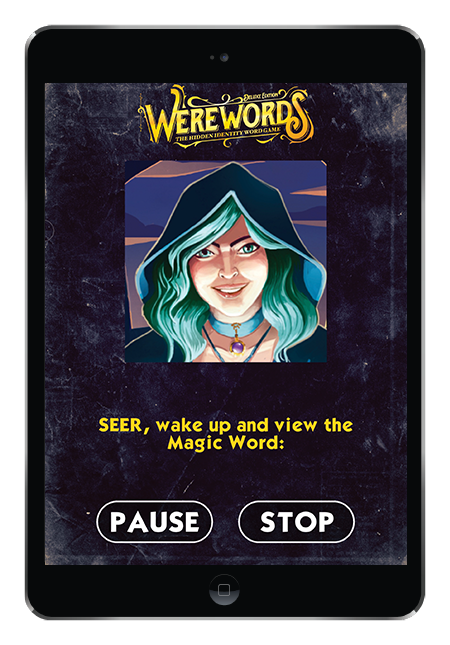
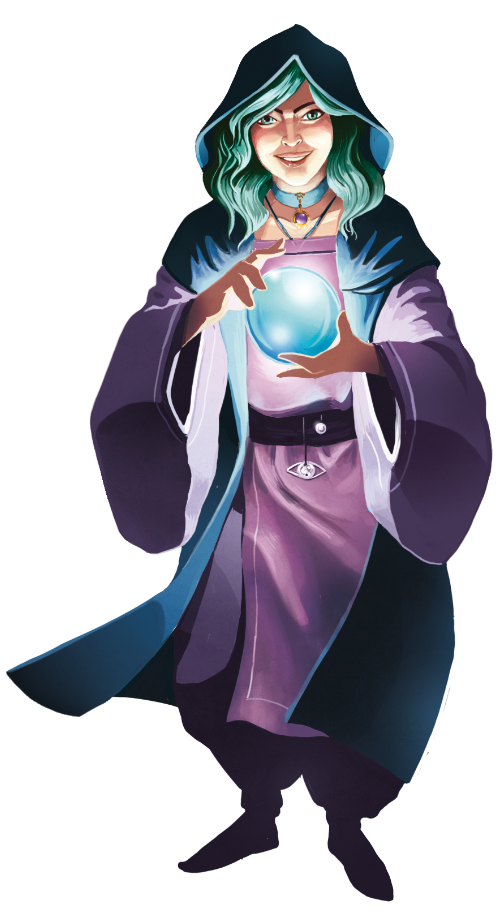
Finally, the app tells the Werewolf to wake up. The Werewolf views the Magic Word. After a few seconds, the app tells the Werewolf to close his eyes.
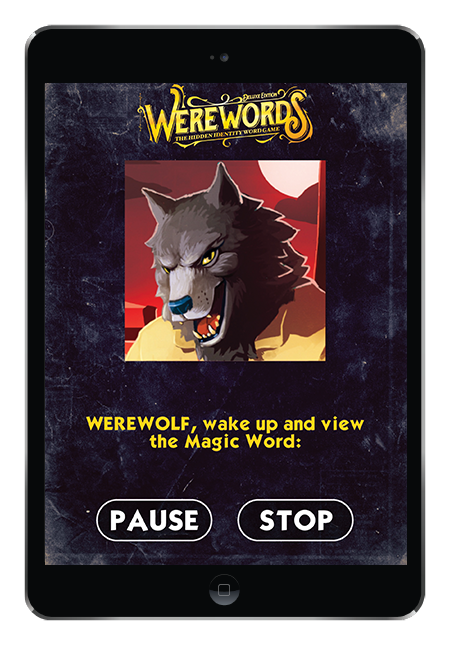
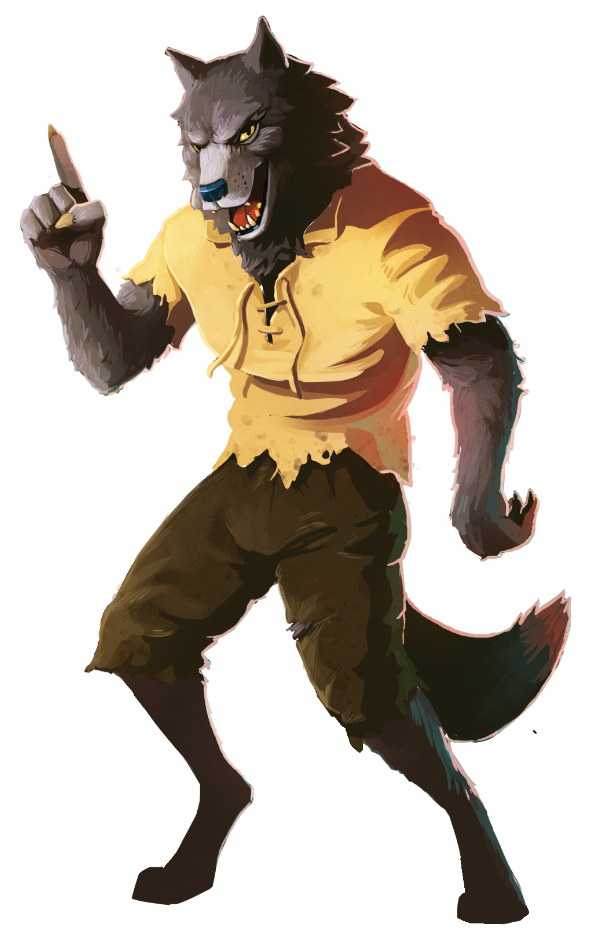
Gameplay: Day Phase
The app then tells everyone to wake up and starts the timer for the Day Phase.
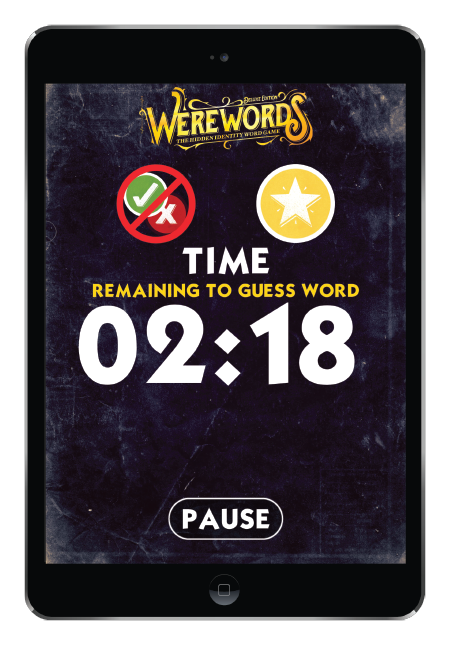
While the timer is running, all the players try to figure out the Magic Word.
The players do this by asking the Mayor questions that require a “yes” or “no” answer. The Mayor may not speak; instead, he must give the person who asked the question an answer token:
Yes/No ( /
/ )—with the appropriate side up, Maybe (
)—with the appropriate side up, Maybe ( ), or So Close (
), or So Close ( ).
).
The Mayor may not point at any players or tokens, or speak until time runs out or the Magic Word has been guessed. The Mayor may not ignore questions posed to him even if they have been previously asked.
If the players are way, way off track (maybe they’ve interpreted an answer poorly or they think they’re very close when they aren’t), the Mayor may place the Way Way Off ( ) token in the middle of the table to indicate that they are indeed way, way off. This token may go to a specific player, but does not take the place of a regular Yes/No (
) token in the middle of the table to indicate that they are indeed way, way off. This token may go to a specific player, but does not take the place of a regular Yes/No ( /
/ ) or Maybe (
) or Maybe ( ) token.
) token.
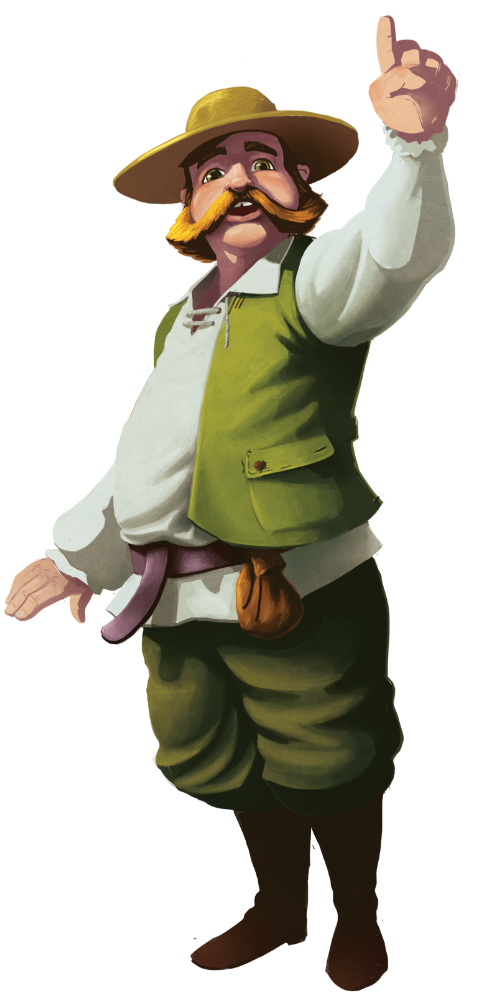
Players may speak to each other during the Day Phase, and can even ask each other questions before posing them to the Mayor. Only one question should be asked of the Mayor at a time. The Mayor may not speak at all, even to verify a previous question and answer.
Players (including the Mayor) may not look up the Magic Word or consult with anything or anyone outside the game regarding the Magic Word until the Day Phase is over.
The tokens are limited—when the last Yes/No ( /
/ ) token is given to a player, the Day Phase is over and the Mayor must tap the No More Yes/No Tokens button on the app.
) token is given to a player, the Day Phase is over and the Mayor must tap the No More Yes/No Tokens button on the app.
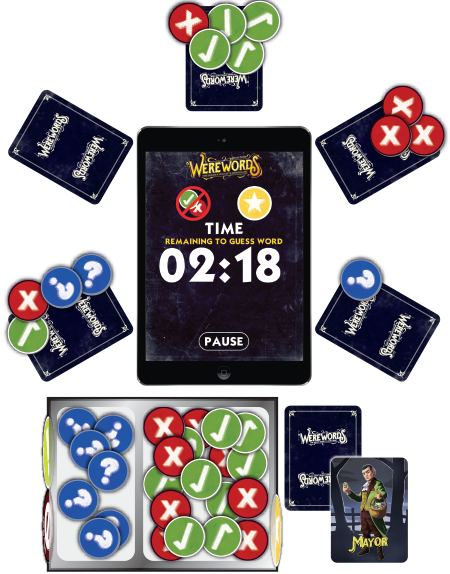
To guess correctly, players must directly ask the complete Word. (e.g., “Is the word ‘frog’?”; “Is it ‘frog’?”)
An indirect guess, even if it includes the Magic Word (e.g., “Is it a kind of frog?”), is not correct. The Mayor might want to use the So Close ( ) token in this case.
) token in this case.
If The Magic Word is Guessed Correctly
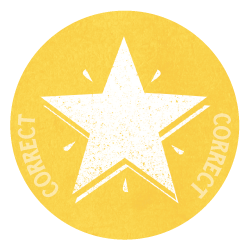
If the players guess correctly before time runs out, the Mayor taps the yellow Correct ( ) button on the app, and then hands the Correct (
) button on the app, and then hands the Correct ( ) token to the player who guessed correctly.
) token to the player who guessed correctly.
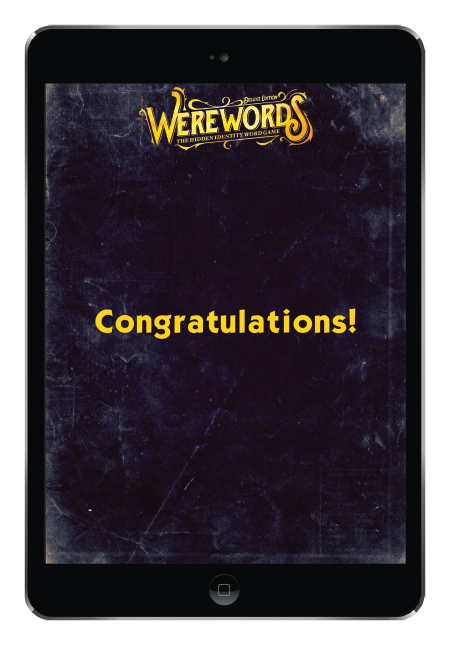
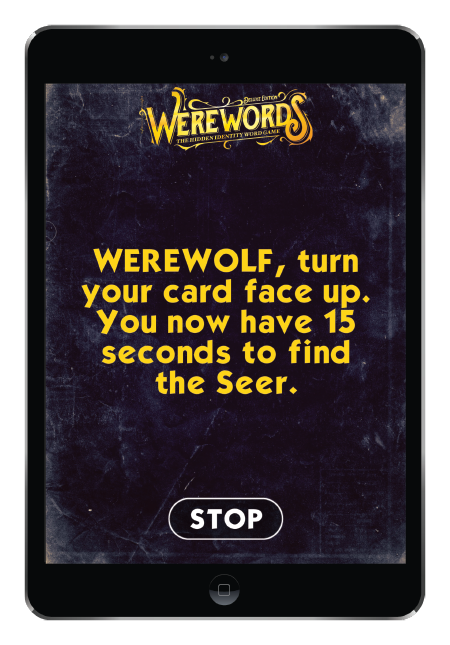
After a correct guess, only the Werewolf shows his card. The Werewolf then has one last chance to win if he can guess who the Seer is.
During this time, all players, including the Mayor, may say anything they’d like to, including what their secret role is. Players are allowed to lie about what their role really is. No one may reveal their role card until after the vote.
The Werewolf has just 15 seconds to decide. Then he must point at a player, who turns over their role card.
If the Werewolf finds the Seer, the werewolf team wins and the village team loses. If the Werewolf does not find the Seer, the village team wins.
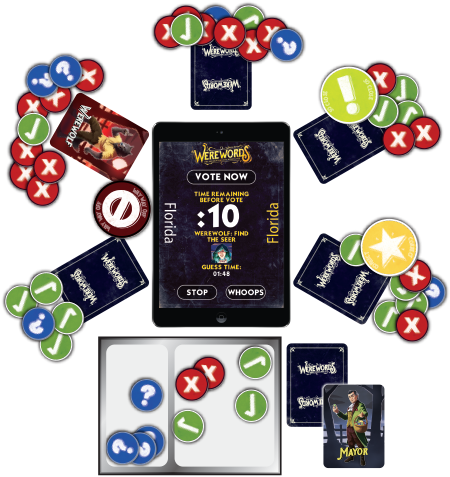
If No One Guesses the Magic Word
If the players don’t guess the Magic Word before time runs out or the No More Tokens button is tapped, players have one minute to discuss among themselves who they think the Werewolf is.
When this discussion starts, players (including the Mayor, who is now allowed to speak) may claim to be certain roles (whether they are that role or not), but may not reveal their cards until the final vote has taken place.
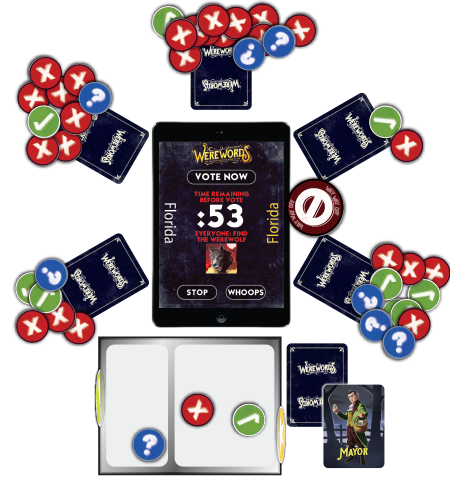
When the minute is up, everyone points at the player they think is the Werewolf (you may not point at yourself). The player with the most votes must reveal their card.
If the majority of players point at a Werewolf, the village team wins and the werewolf team loses. If they do not, the werewolf team wins.
If there is a tie for the most votes, all tied players reveal their cards. If any of them is a Werewolf, the village team wins and the werewolf team loses. If each player receives one vote, the werewolf team wins.
Whoops
Sometimes you’ll guess the Word just as time runs out, and the Mayor doesn’t have time to tap the Correct button before the app announces that time has run out. Or maybe the Mayor tapped the Correct button accidentally, when the Word actually had not been guessed.
Either way, you can get things back on track by tapping the Whoops button in the lower right; this will display the other endgame condition than the one currently shown on the app.
Play Again
If you want to play again quickly, tap the Play Again button on the screen that appears at the end of the game. You can also change the difficulty level on this screen.
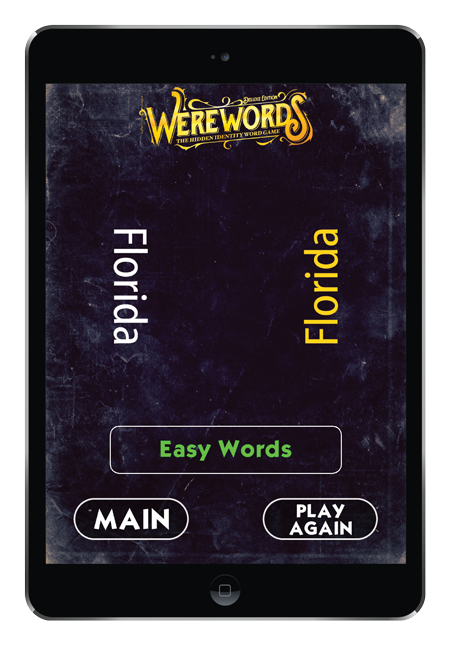
Werewolf-Mayor
If the Mayor is a Werewolf, he doesn’t want the players to guess the Word; his winning condition is the same as any other Werewolf. In this case, the Mayor might want to choose a slightly harder Magic Word. During the Day Phase, the Werewolf-Mayor may mislead or even lie to the players when giving tokens to lead them away from the correct answer.
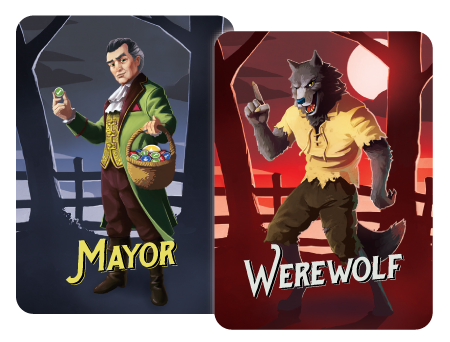
Seer-Mayor
If the Mayor is the Seer, he wants the village to guess the Word. Because he doesn’t have a Seer to help him out, he might want to choose a slightly easier Magic Word. Of course, if the Word is too easy, the Werewolf might figure out that the Mayor is the Seer.
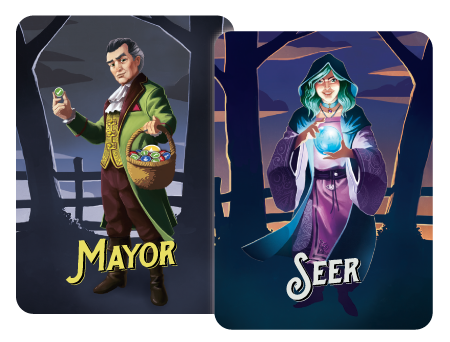
More Werewolves
If you have seven or more players, add a second Werewolf to the game. If you have twelve or more players, add a third Werewolf to the game. Always keep the total number of cards, including the Mayor, to one more than the number of players.
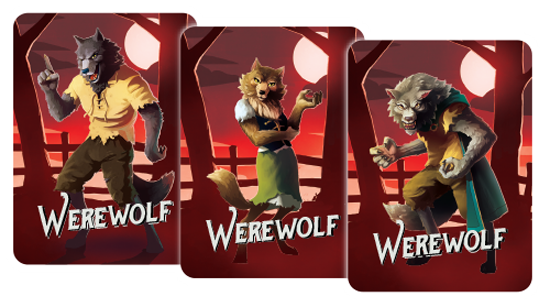
When using a second Werewolf, the app allows each Werewolf a chance to see who the other Werewolf is right before they view the Magic Word.
If the Magic Word is guessed correctly, each Werewolf may vote for a different player, and both of those players must reveal their cards—if either one is the Seer, the Werewolves win.
If the Magic Word is not guessed correctly, the players only have to find one of the two Werewolves to win. As long as either Werewolf gets the majority of votes, the village team wins and the werewolf team loses.
Basic Strategy
Start by asking general questions of the Mayor to learn the category of the Magic Word instead of guessing it outright. Asking questions such as “Is it a person?” or “Can I buy it in a store?” or “Is it bigger than a breadbox?” quickly narrow the search down for all players.
All village team players should pay attention to everyone who asks questions. If someone seems to be playing slowly or trying to derail the line of questioning, that person just might be a Werewolf.
The Seer has to be careful not to make her knowledge so obvious that the Werewolf will know who she is.
A Werewolf should, without making it too obvious, attempt to slow down the rate in which the group reaches their conclusion and use up tokens with questions that don’t really help the other players.
A Werewolf should also pay attention to the other players to try to spot the Seer.
When the Word is not guessed correctly, it’s always a good idea for all players with special roles on the village team to state who they are, as this reduces the number of players that can be Werewolves. Players may not turn their cards over until after everyone has voted.
Apprentice
The Apprentice steps in to be the Seer when the Mayor has the Seer role card. When the Apprentice is in the game, the village is guaranteed to have help from a player who knows the Magic Word.
The player with the Apprentice card is called by the app during the night, and told to look at the screen. If the Mayor is the Seer, the Apprentice player will see the Magic Word.
Of course, if the village figures out the Magic Word, the Werewolves can still win… but now they are looking for the Apprentice, not the Seer. The app will tell the Werewolves who to look for (the Seer or the Apprentice) when it is time to vote.
The Apprentice also takes over for the Fortune Teller if the Mayor is the Fortune Teller (see page 14).
The Apprentice also makes voting a little bit easier for the werewolf team, as they never need to consider the Mayor when looking for the Seer.
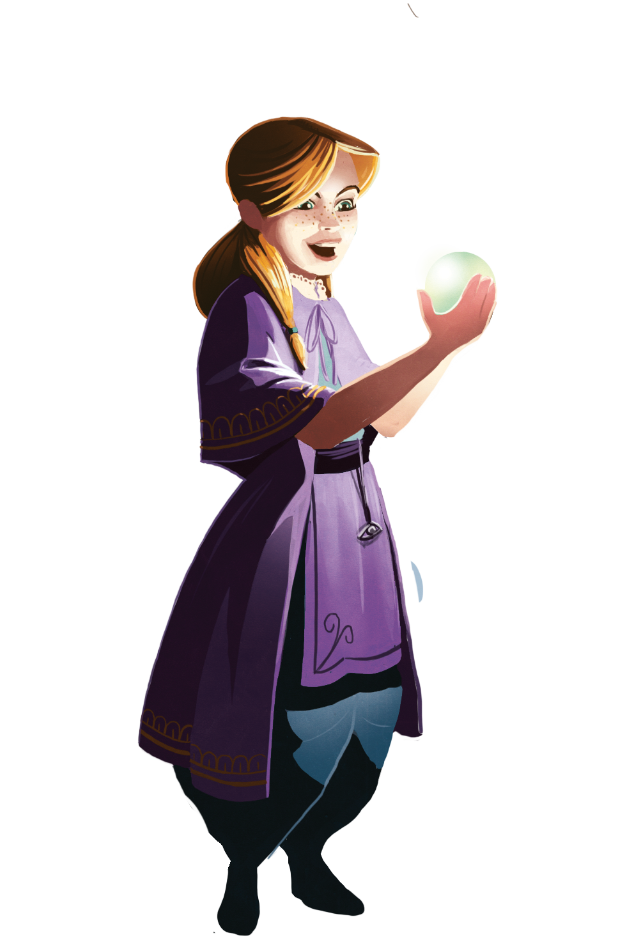
Masons
The Masons wake up at night to see who the other Mason is. The Masons are on the village team, and knowing another player on the village team allows them to trust that person and his guesses during the game.
If you select only one Mason and no Doppelgänger (see page 15) on the main screen, the Masons will not be called to wake up at night (as there would be no one to see). Masons are best for large groups that have 10 or more players.
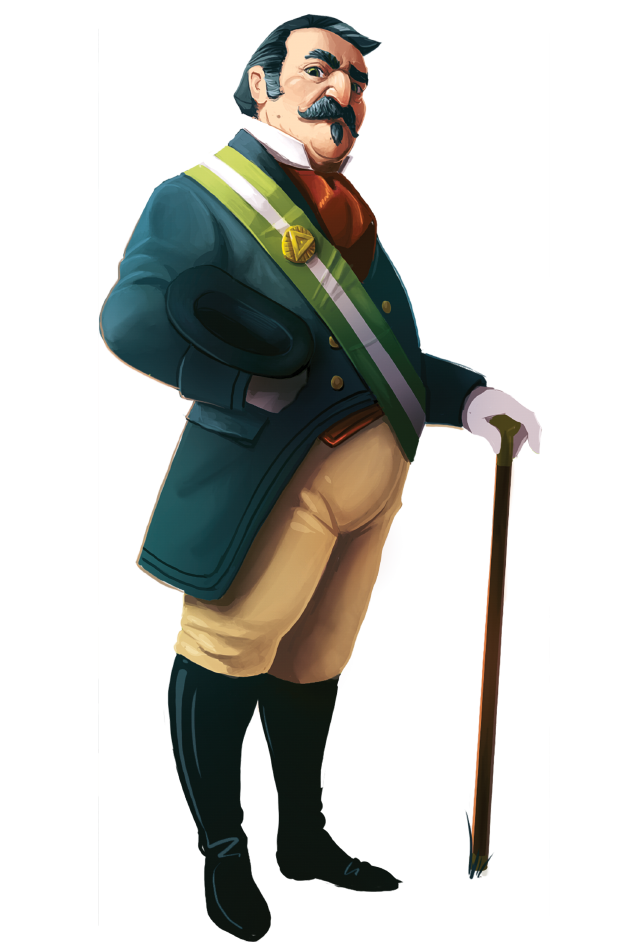
Thing (that goes bump in the night)
The Thing wakes up each night and taps the nearest shoulder of one of its neighbors. This lets that neighbor know that the Thing is sitting next to them. The Thing player is on the village team.
This is good for the village team because if a village team player feels a tap, they know that the Thing player is not a Werewolf. It’s bad for the village team because if the Thing taps a werewolf team member, the werewolf team knows that the Thing player is not the Seer.

Beholder
The Beholder wakes up and sees which player is the Seer. The Beholder is on the village team. If a Werewolf points to the Beholder (and not the Seer) when the Magic Word is correctly guessed, the village team still wins.
If the Fortune Teller is in the game, the Beholder sees which player is the Fortune Teller. If both the Seer and Fortune Teller are in the game, the Beholder sees both of them.
If the Apprentice is in the game with the Seer and/or Fortune Teller, the Beholder sees the Apprentice in addition to the Seer and/or Fortune Teller.
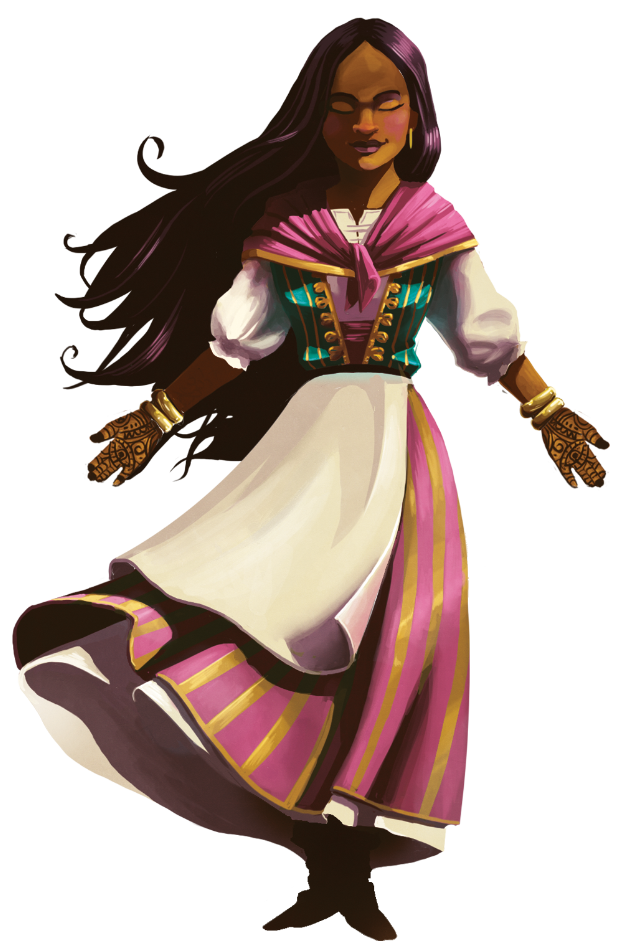
Minion
The Minion wakes up at night and sees who the Werewolves are. The Minion is on the werewolf team.
If the majority of players point to the Minion when the Magic Word has not been guessed, the village team still wins just as if they had found a Werewolf. If the Mayor is the Minion, he may lie just as if he was a Werewolf.
The Minion does not vote with the Werewolves when they are trying to find the Seer. The Minion does not reveal his card (like the Werewolves do) when the Magic Word is not guessed.
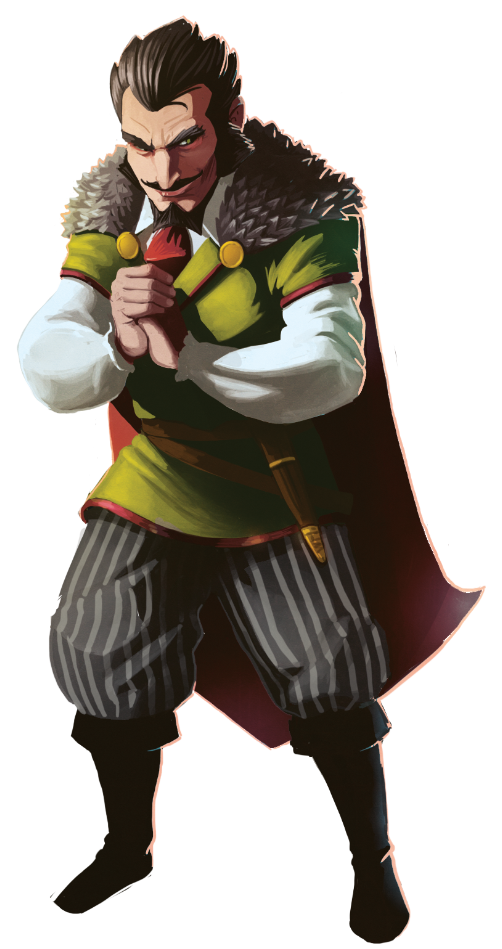
Fortune Teller
The Fortune Teller wakes up and sees the first letter of each word in the Magic Word.
If the players guess the Magic Word correctly, the Werewolves can still win by pointing to the Fortune Teller. If the Seer and the Fortune Teller are both in the game, the Werewolves win if they point to either the Seer or the Fortune Teller.
When playing multiple games in a row, the Fortune Teller is shown additional letters in each word when the players do not guess the Magic Word in previous games.
You can specify how many letters at the beginning of a word the Fortune Teller sees by going to the Fortune Teller settings in the app.
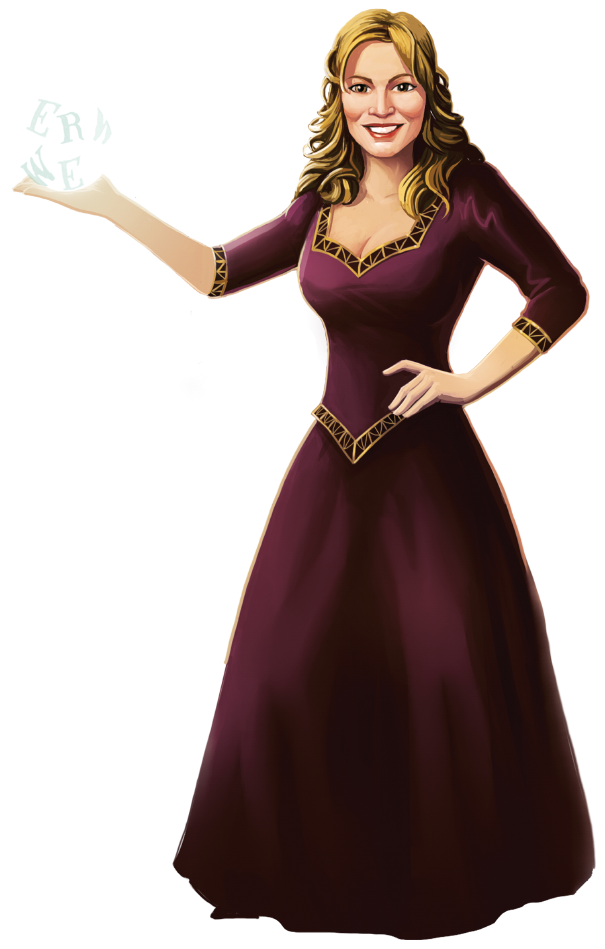
Doppelgänger
The Doppelgänger wakes up, looks at another player’s card, and taps that role in the app. The app then gives information to the Doppelgänger based on the role that she viewed:
Villager: The Doppelgänger is a simple Villager.
Seer: The Doppelgänger is shown the Magic Word. She does not wake up when the Seer is called later in the night.
Fortune Teller: The Doppelgänger is shown the first letter of each word in the Magic Word. She does not wake up when the Fortune Teller is called later in the night.
Apprentice: The Doppelgänger is shown the Magic Word if the Mayor is the Seer, or the first letter of each word in the Magic Word if the Mayor is the Fortune Teller. She does not wake up when the Apprentice is called later in the night.
Minion: The Doppelgänger is told to wake up when the Minion wakes (she’ll see the Minion, who will also see her, as well as who the Werewolves are). She now wins with the werewolf team.
Beholder: The Doppelgänger is told to wake up when the Beholder wakes (she’ll see the Beholder, who will also see her, as well as who the Seer is).
Werewolf: The Doppelgänger is told to wake up with the Werewolves. She’ll see who the other Werewolves are, they will see that she is a Werewolf as well, and she’ll see the Magic Word. The Doppelgänger now wins with the werewolf team.
Mason: The Doppelgänger is told to wake up with the Masons. She’ll see who the Masons are, and they will see who she is.
Thing: The Doppelgänger is told to tap the player on her left or right immediately. She does not wake up when the Thing wakes up later in the night.
If the Doppelgänger looked at the Seer or Fortune Teller card (or the Apprentice in a game where she gets to see some or all of the Word), the Werewolves can win by pointing to the Doppelganger instead of the player with the actual card (the app will state the valid targets right before voting).
If the Magic Word is not guessed and the Doppelgänger viewed a Werewolf or Minion card, the village team can also win by identifying the Doppelgänger.
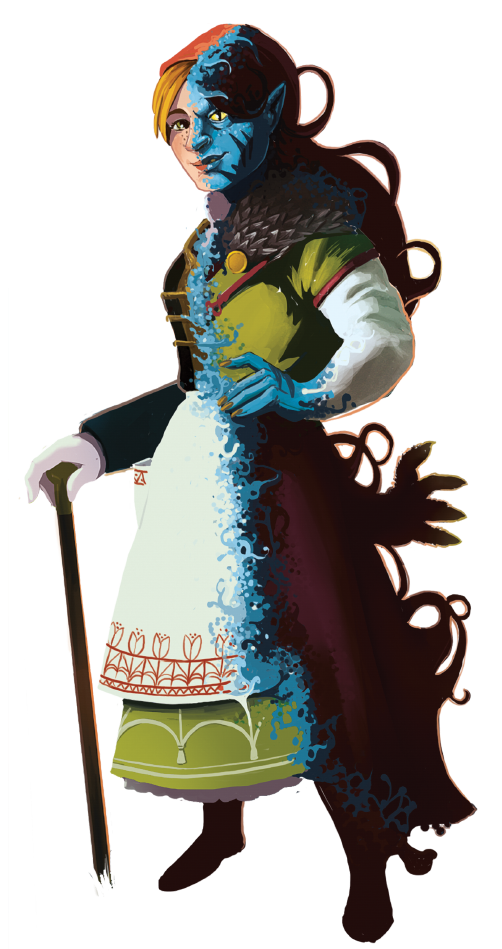
Rules for 2 Players
To play Werewords with two players, use the Mayor, a Villager, a Werewolf, and either the Seer or Fortune Teller cards.
Start by giving the Mayor to either player; players alternate being Mayor in subsequent games.
Then shuffle the other three cards and deal one to each player, putting the extra card off to the side.
In the app, select only the Werewolf and the Seer or Fortune Teller. This tells the app that you are playing with only two players, so special endgame conditions apply.
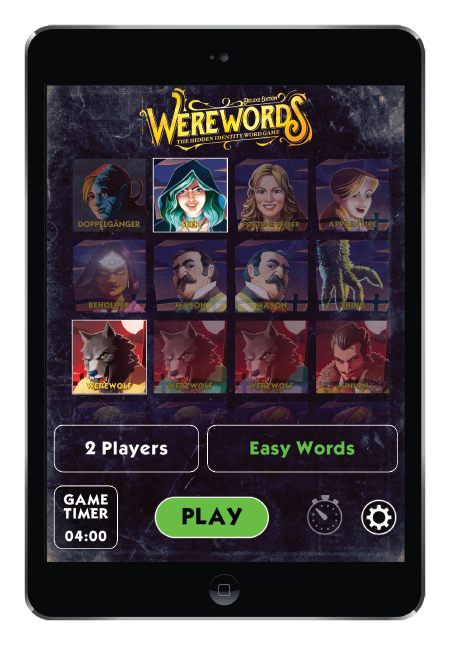
Tap the Play button and play the game as normal, until the Magic Word is guessed or time/tokens run out.
If the Word was guessed correctly, the Werewolf reveals his card, and must decide whether the other player was the Seer/Fortune Teller. When time runs out, the Werewolf points at either the other player or the extra card. He wins if he correctly identifies the Seer/Fortune Teller. If neither player was a Werewolf when the Word was guessed correctly, both players win!
If the Word was not guessed correctly, both players discuss who they think the Werewolf is, but unlike in the regular game, players may not claim to be the Seer/Fortune Teller or the Villager. Then both players point at either the other player or the extra card.
If either player points to the Werewolf, that player wins. If the Werewolf is the extra card, both players can win if they both point to it. If the Werewolf is a player and is pointed at, he loses. If the Werewolf is a player and is not pointed at, he wins.
Playing the game with two players is a little unusual, because more often than not, both players know the Magic Word, but the guessing player has to pretend he doesn’t. It’s more about bluffing, but in the case where the Mayor is the Seer and the other player is the Villager, it’s about getting the Word right, which assures a victory for both players.
Rules for 3 players
To play Werewords with three players, use the Mayor, a Villager, a Werewolf, and either the Seer or Fortune Teller cards. Deal them out as usual, with the player who receives the Mayor getting the extra card.

Gameplay is exactly like the regular Werewords game, but the emphasis is much more on bluffing and trying to figure out what roles the other players are.
In the case where the Mayor is the Villager, it means all three players know the Magic Word, and the Mayor knows the other two know the Magic Word, but those other two players have to act like they don’t know it. And the Mayor can’t say anything, because that would give away who the Seer is!
Playing with three players can be a really fun, unusual way to play Werewords, and will result in a lot of interesting strategies that you won’t see in a regular game.
Playing Werewords with Young & Old
Some young players might have trouble knowing some of the words that appear in Werewords. Likewise, some older players might not be aware of some of the more current words in the game.
This is compounded further when both young and old players are in the same game, as their knowledge of people, places, brand names, titles, and other pop culture references don’t always overlap.The app has settings you can adjust so that those with different backgrounds and frames of reference can play together.
One of the most effective things to do is to change the Mayor’s choice of words to 5. Normally this number scales with the difficulty settings (2 words on Easy through 5 on Ridiculous), but you can override that in the Mayor Choice settings.
Another helpful setting is to turn off Proper Nouns, which will prevent any words that start with a capital letter from appearing.
Encourage everyone to choose words they think all players will know when they are the Mayor. Of course, if the Mayor is a Werewolf, he’ll have to decide if he can get away with choosing a word that is a little less likely to be guessed by everyone, or if doing so will give away his role.
Playing Werewords with Large Groups
Once you get to about 10 players, follow these tips to enhance your playing experience:
Device Placement
One of the biggest issues you’ll face with large numbers of players is access to the mobile device. Play with a large phone or a tablet if possible to ensure everyone can see the screen when they wake at night.
The Mayor should always push the device to the center of the table after he has chosen the Magic Word.
Playing on a long banquet-style table is more difficult than at a larger round table; if all you have are banquet tables, push two together so you don’t have any players at the “ends.”
If playing with the Doppelgänger or Speedwords™ (see page 20), some players may need to reach the device during the Night Phase. With a large group, have the players stand up through the Night Phase; this allows the players who have to reach the device to do so without accidentally bumping the table or otherwise exposing their identity accidentally.
Third Werewolf
Add a third Werewolf once you get to about 12 players. This gives more targets for the village when the Word is not guessed, and gives the Werewolves three chances to find the Seer.
Fortune Teller & Seer
You can play with both the Fortune Teller and the Seer.
Around the 15-player mark, consider adding in the Apprentice as well.
To make things really difficult for the Werewolves, add the Beholder too; the Beholder can ensure that the village team knows four players who are not Werewolves if she speaks up right before the vote.
Masons
Masons are a big boost to the village team, especially with large player numbers. When the Magic Word is not guessed, the Masons should reveal themselves, giving the village team two fewer targets.
Avoid Crosstalk
It can be difficult for the Mayor (and other players) to hear questions with a large number of players, so be sure to wait to ask a question until other people are done asking (or speaking).
Creating Rolesets
You can mix and match roles as much as you’d like, as long as you keep a few basic concepts in mind:
- Include more Villagers than Werewolves and the Minion combined.
- Always have a Seer or Fortune Teller, and at least one Werewolf.
- Don’t change roles out between every game. Add or subtract different roles frugally; switching things around too fast can be confusing for players who have to try to remember what roles are in the game.
Here are a few good sample rolesets at different player counts:
4 Players
6 Players
9 Players
12 Players
18 Players
Speedwords™
For a change of pace and a quick challenge, try Speedwords, where players have more information about the Magic Word, but less time to figure it out.
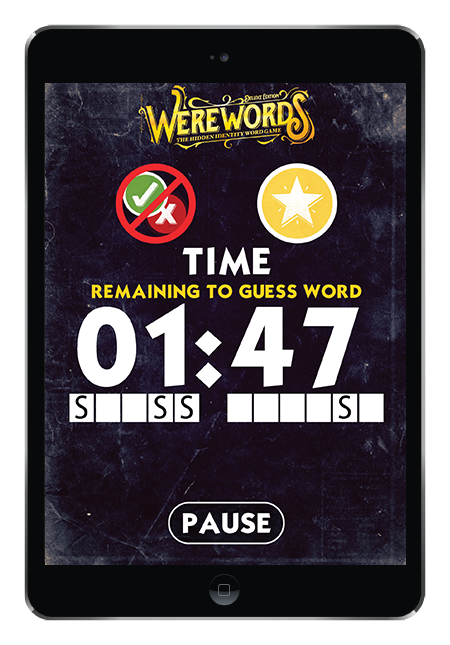
To activate Speedwords, tap the stopwatch button next to the Play button. The Play button will change to Play Speedwords, and the Game Timer will change to a Speed Timer which is equal to one-half the Game Timer time.
The game is played as normal, but now when the Werewolves wake up, they’ll be asked to tap a letter on the app screen. That letter will be shown to all players once the Night Phase is over, as well as the words and the number of letters in each word.
Custom Word Lists
You can add your own custom word lists to the Werewords app.
Word lists can be assigned any of the four difficulty levels, and you can quickly paste in word lists right on your mobile device.
Download word lists submitted by other players, all categorized by age appropriateness and difficulty level, directly into your app, and go to werewords.com to submit your own custom word lists.
Add you own custom word lists or search through lists submitted by other players on this site, to find custom word lists from other players that you can put in your app, and to submit your own custom word lists, all categorized by difficulty level and age appropriateness.

